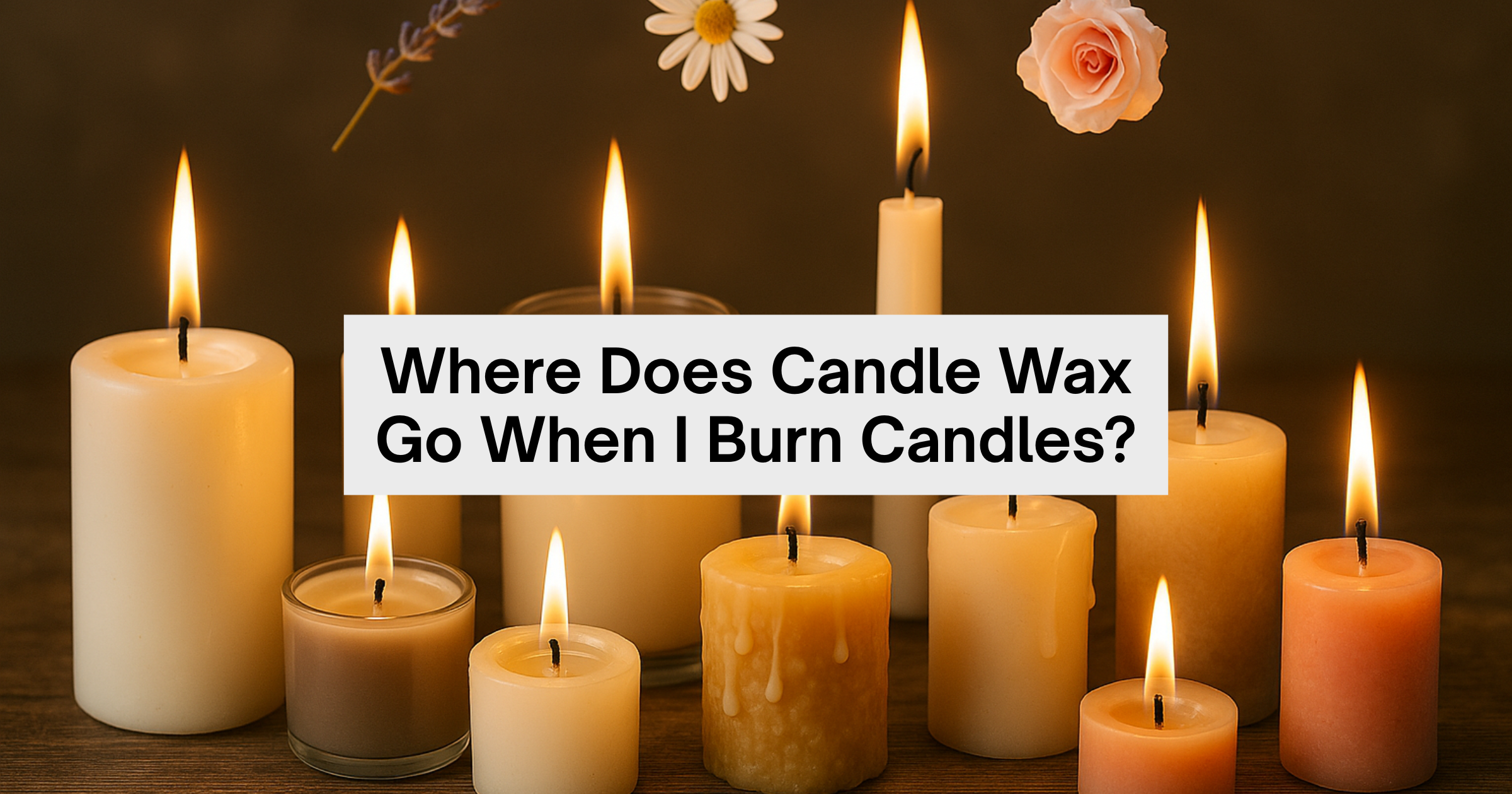No products in the cart.
Where Does Candle Wax Go When I Burn Candles?
- Nav Preet
- No Comments

Candle wax doesn’t disappear; it turns into gases that fuel the flame, producing light, heat, and fragrance. When you burn a candle, the wax melts, travels up the wick, and undergoes a fascinating transformation that keeps the flame alive.
Curious how this process actually works? Keep reading the blog to learn what happens to candle wax, why some of it turns into soot, and how you can make your candles burn cleaner and longer.
By the end, you’ll know exactly what happens to wax and why candle wax burns safely and beautifully every time you light a candle.
Material Used in Candle Wax
When people ask, “Does candle wax burn?” the answer is yes—but only after it melts and vaporizes.
Wax doesn’t burn as a solid. Heat melts the wax, the liquid travels up the wick, and then turns into a gas that fuels the flame, creating light, fragrance, and heat.
Paraffin Wax: The most common and affordable option, paraffin comes from petroleum. It delivers a strong scent throw but can create soot if the wick isn’t trimmed.
Soy Wax: Made from soybean oil, soy burns slower and cleaner than paraffin. It lasts longer, leaves less residue, and is often chosen for its eco-friendly appeal.
Beeswax: A natural, traditional wax that burns cleanly with minimal soot. It releases a warm, honey-like aroma and can help neutralize odors.
Palm Wax: Hard and crystalline, palm wax makes beautiful pillar candles. However, sustainability concerns have reduced its popularity.
Coconut Wax: A newer, sustainable choice with a creamy finish, slow burn, and excellent scent throw. Often blended with soy for stability.
Where Does Candle Wax Go?
The most common question people ask is where the wax goes in a candle or where does wax go when you burn a candle. At first, it looks like the wax is simply disappearing, but in reality, it is transforming.
When you burn a candle, the solid wax turns into liquid, then vapor, and finally into carbon dioxide and water vapor. These are invisible, which is why you can’t see them leaving the candle.
Think of it like breathing on a cold day — your warm breath turns into visible mist for a second, then vanishes into the air.
The candle is doing the same thing, only with wax molecules instead of water from your lungs. This is why the wax line in a jar slowly lowers as the candle continues to burn.
So, where does the candle wax go exactly? Most of it becomes carbon dioxide, which mixes with the air, and water vapor, which dissipates into the room.
A small portion can become soot if combustion isn’t complete. Soot is the black residue you might see on a jar or notice floating up in smoke.
People sometimes think that wax drips down and collects somewhere hidden, but in truth, almost all of it is consumed in the form of gases.
This is why a candle that burns properly leaves little to no wax behind. If you do notice leftover wax at the bottom of a jar, it usually means the wick couldn’t reach it or the candle wasn’t burned long enough for the melt pool to spread evenly.
Understanding this simple science helps you see why wax never just vanishes. Next time someone asks where candle wax goes when I burn candles, you can explain that it becomes part of the air in the form of gases that carry fragrance, light your room, and warm the atmosphere.
Candle Wax Burning Process
Many people assume that the flame burns the solid wax directly, but the reality is far more interesting.
To truly answer questions like “Does candle wax burn?” or “Where does the wax go when I burn a candle?” it helps to break down the process step by step.
Step 1 – Wax Melts Near the Flame
The flame first melts the wax closest to the wick, forming a liquid pool. This liquid wax becomes the candle’s fuel source.
Solid wax itself cannot ignite, which is why melting is always the first stage.
Step 2 – Wax Travels Up the Wick
The liquid wax moves upward through the wick via capillary action, just like water climbing a paper towel.
Wick fibers act as channels, steadily feeding melted wax to the flame.
Step 3 – Wax Vaporizes
When the liquid wax reaches the flame’s hottest point, it vaporizes. This is the critical stage because only vaporized hydrocarbons can react with oxygen and combust.
In other words, candles burn on wax vapor, not on solid wax.
Step 4 – Combustion
The vaporized wax molecules combine with oxygen in the air, releasing heat, visible light, carbon dioxide, and water vapor. This transformation is what makes the flame dance.
If oxygen is limited, incomplete combustion occurs, and some of the vapor becomes black carbon particles, or soot.
Seeing the process step by step makes it clear: the flame doesn’t consume the solid wax itself. It burns the vapor, and that’s why candles burn steadily and consistently once they’re lit.
Why Candle Wax Produces Smoke and Soot
Once you understand how clean burning works, it’s easier to see why candles sometimes misbehave. Smoke or soot on jars and walls comes from incomplete combustion—when wax vapor doesn’t fully react with oxygen.
The main cause is an oxygen imbalance. In drafty rooms or when airflow is blocked, the flame flickers, oxygen supply becomes uneven, and carbon particles form instead of clean gases.
Another reason is wick length. A wick that’s too long pulls up more liquid wax than the flame can burn, overwhelming the combustion process and producing smoke. Trimming the wick before each use is the simplest way to prevent soot.
The type of wax also makes a difference. Paraffin tends to produce more visible soot compared to soy, beeswax, or coconut blends. Additives like dyes or high fragrance loads can also contribute to smoky burns.
So, when people ask “Does candle wax burn cleanly?” the answer is yes—but only when combustion is balanced.
Under ideal conditions, wax becomes only carbon dioxide and water vapor. Without enough oxygen, the result is soot.
How to Avoid Soot in Candles
Soot can spoil even the best candle experience, but a few simple habits ensure your candle burns evenly and cleanly:
- Trim the wick regularly. Keep it around a quarter inch. This controls the fuel supply and prevents excess wax vapor from overwhelming the flame.
- Burn in a calm environment. Drafts from fans, open windows, or vents cause flickering flames and turbulent air, leading to soot.
- Choose high-quality wax. Soy, beeswax, and coconut blends typically burn more evenly than low-grade paraffin with additives.
- Burn long enough for a full melt pool. Allow the top layer of wax to melt across the entire surface (usually one to three hours). This prevents tunneling and uneven burns.
- Maintain balanced ventilation. While drafts are harmful, a completely closed room can also starve the flame. Gentle airflow supports cleaner combustion.
When these practices come together, candles burn with minimal smoke, full fragrance release, and an even wax pool—delivering the cozy ambiance they’re meant to provide.
Final Thoughts
So, where does candle wax go when it burns? The answer is simple but fascinating: wax doesn’t vanish—it transforms. Solid wax melts, vaporizes, and becomes carbon dioxide and water vapor, with only traces turning into soot under less-than-perfect conditions.
Understanding this process not only satisfies curiosity but also makes you a smarter candle user. By trimming wicks, choosing quality wax, and burning candles in calm, balanced environments, you can enjoy flames that glow cleanly and fragrances that linger without smoky residue.
The next time you light a candle in a quiet room, you’ll know exactly what’s happening. The wax is fueling the flame, carrying fragrance through the air, and creating the warmth and comfort that make candles magical.
Frequently Asked Questions
Does candle wax actually burn, or does it just melt?
Candle wax first melts into liquid form, then travels up the wick and vaporizes. It’s the vaporized wax that burns, not the solid wax itself.
Why does my candle seem to use up so much wax quickly?
If the wick is too large or not trimmed, it can pull up excess wax, making the flame bigger and the candle burn faster. Always trim to a quarter inch for an even, slower burn.
Is it safe to inhale candle wax fumes?
When burned properly, candle wax turns into carbon dioxide and water vapor, both harmless at normal household levels. Problems only arise when there is excessive soot, which can be avoided with proper care.
Why does some wax remain at the bottom of the jar?
This usually happens when the wick cannot reach the last layer of wax, or if the candle wasn’t burned long enough in earlier sessions to create a full melt pool.
Where does candle wax go when it burns completely?
It becomes invisible gases — mainly carbon dioxide and water vapor — that dissipate into the air, along with the fragrance molecules you smell while the candle burns.

Nav Preet is the founder and creative soul behind Karigar Candles. Inspired by heritage, nature, and the warmth of handmade artistry, she crafts candles that do more than glow—they evoke emotion. Through this blog, she shares her love for scents, styling, and mindful living, one flame at a time.
Creative Head at Karigar Style







